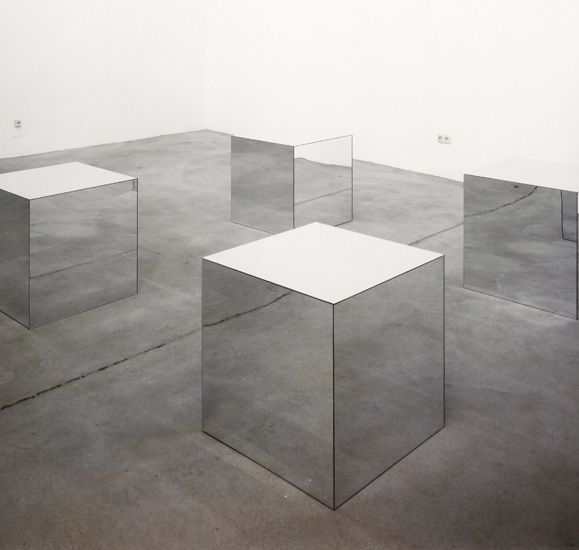By Aaron Kreisler
Seeing sound and hearing vision.
Some time ago I was showing my students a series of images relevant to an upcoming exam when a particular one embedded itself in my brain. It was an iconic black and white photograph of Wystan Curnow standing in the middle of Robert Morris’s Untitled (1965), a minimalist four-component white sculpture from the international touring exhibition Some Recent American Art at the Auckland City Art Gallery in 1975. What makes this such a mesmerising image is not simply the importance of this art-historical moment – innovative New Zealand art writer encounters renowned international experimental art practice – it is also the almost palpable sense of concentration that grips the central figure. But I was struck by another aspect of this image: there seemed to be a strange correlation between this floor-bound modular artwork and a sci-fi aesthetic that came about in the same era. Was it a coincidence that during the space race artists and film-makers on the west coast of the US found solace in a stripped-back, sparse visual language? Or maybe it’s much simpler than that – after all, there is not a huge divide between earning a crust making film props and living the dream of being a fulltime sculptor.
When walking up the central staircase at the Govett-Brewster Art Gallery, which Billy Apple redesigned in 1979 into an artwork titled Altered Staircase: the given as an art political statement, it is difficult not to be seduced by the history of this site. This historical trace is important because it is a reminder of the significant projects that have occurred here and is also an intellectual bridge that speaks directly to the exhibitions that grace the space today. On this visit, the transitory site was transformed by the mixing of ambient sounds that were filtering down from the upper gallery spaces. The source of this discordant soundscape was What Sound Does a Colour Make? The Govett-Brewster was the only Australasian venue for a show that was generated by the Independent Curators International and has otherwise toured only in the US. One should not be surprised to find this show in New Plymouth – there is still is a prevailing mentality for directors and curators to intellectually think big.
One of the premises of this exhibition is that the basic human senses are transmutable and that under certain physical, mental or environmental conditions this can be revealed – for example, when hearing a sound evokes the appearance of a colour. The show brings together a vast array of audiovisual artists who play with the relationship between image and sound. This is most succinctly articulated in Jim Campbell’s Self-Portrait of Paul (DeMarinis) (2003), where a seemingly innocuous assemblage of basic sound devices (a microphone, speaker and LED screen) actually produce a richly layered artwork: a recorded voice is played out across the space into a microphone that decodes the sound and then renders a sensory portrait of the artist’s physical features in light.
When moving through the show, it becomes abundantly clear that some serious research and development has gone into the production of these mind-altering and sensory-overloading artworks – the nexus between art studio and science lab feels very close. Each art booth provides an insight into the depths of the aural/visual spectrum, from Granular-Synthesis’s LUX (2003), in which a constantly unfolding series of colour fields has a matching set of rumbling sound waves, to Thom Kubli’s Monochrome Transporter (2003), where everything is pared down to a series of essential parts and a single monitor broadcasts the most elemental digital message – the blue screen – while the pulsating tones of the accompanying score seem to be synchronised to the subtle coloration shifts emanating from the monitor. This exhibition provides a useful insight into the complex relationships between image and sound, but as I left this grand audiovisual extravaganza, to what sounded distinctly like the synthesised score to Blade Runner (coming from Atau Tanaka’s Bondage, 2004), it did feel a bit like all these special effects were being produced for a very particular audience – other video/sound artists.
Article originally published in the New Zealand Listener
http://www.listener.co.nz
© APN Holdings NZ Ltd
